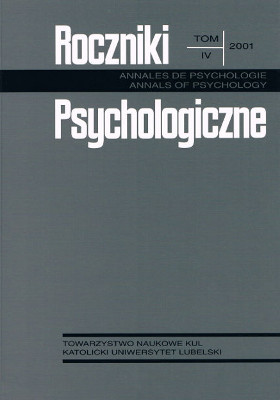The Cognitive Scheme in Perceptual Categorization
Abstract
Perceptual categorization is a domain of the research on cognitive processes which combines perception with conceptual thinking. The paper discusses problems connected with the recognition of perceptual structures in the light of contemporary models of categorization. An analysis of a prototypical model, statistic and exemplary, has shown that various manners of operationalization of the concept of the recognition of structures, in respect of the assumed theory of the processes of categorization. The basic question here which a given theory is to answer is the following: does a man in the process of categorization creates or discovers a specimen most typical of a given class, as it is assumed in the prototypical model? Or, does it only memorize its particular specimen, which is in line with the assumptions of the exemplary model?
The characterization of the cognitive representation of perceptual category points that specimens belonging to a given class are much more similar to one another, than to the specimens of other categories. This seems understandable in the light of the physical structure of stimuli which constitute a category and sensorial limitations of man. However, in some empirical research it was shown that the perceived similarity between specimens is not constant, but it changes in respect of the manner of categorization. An analysis of the cognitive scheme has been presented here in the context of a statistic, prototypical, and exemplary model of categorization.
References
Barsalou, L. W. (1985). Ideals, central tendency, and frequency of instatiation as determinants of graded structure in categories. Journal of Experimental Psychology: Learning, Memory and Cognition, 11, 629-654.
Bartlett, F. C. (1932). Remembering, a study in experimental and social psychology. Cambridge: Cambridge University Press.
Falkowski, A. (1989). Poznawcza reprezentacja w symulacyjnych modelach kategoryzacji struktur percepcyjnych. (W:) A. Biela, Z Uchnast, A. Januszewski (red.), Wykłady z psychologii w KUL 1987/1988 (s. 23-40). Lublin: RW KUL.
Falkowski, A. (1990). Podobieństwo poznawcze w kategoryzacji percepcyjnej: Badania empiryczne w egzemplarzowym modelu kategoryzacji. Przegląd Psychologiczny, 33, 293-312.
Falkowski, A. (1993). Cognitive similarity in scientific discovery: An ecological approach. W: J. Brzeziński, S. di Nuovo, T. Marek, T. Maruszewski (red.), Creativity and consciousness: Philosophical and psychological dimensions (s. 185-200). Amsterdam–Atlanta: GA: Rodopi B. V.
Falkowski, A. (1999). Stałość poznawcza, analogia i odkrycie naukowe. Czasopismo Psychologiczne, 5, 77-89.
Falkowski, A., Feret, B. (1990). Prototype and exemplar models in categorization: A simulatory comparative analysis. Polish Psychological Bulletin, 21, 199-211.
Flannagan, M. J., Fried, L. S., Holyoak, K. S. (1986). Distributional expectation and the induction of category structure. Journal of Experimental Psychology: Learning, Memory, and Cognition, 12, 241-256.
Fried, L. S., Holyoak, K. S. (1984). Induction of category distributions: A framework for classification learning. Journal of Experimental Psychology: Learning, Memory, and Cognition, 10, 234-257.
Gibson, J. J., Gibson, E. J. (1957). Continuous perspective transformations and the perception of rigid motion. Journal of Experimental Psychology, 54, 129-138.
Hebb, D. O. (1949). The organization of behaviour. New York: Wiley-Interscience.
Holland, J. H., Holyoak, K. J., Nisbett, R. E., Thagard, P. R. (1986). Induction: Process of inference, learning, and discovery. Cambridge: MIT Press.
Holyoak, K. J., Koh, K. (1987). Surface and structural similarity in analogical transfer. Memory and Cognition, 15, 332-340.
Medin, D. L., Schaffer, M. M. (1978). Context theory of classification learning. Psychological Review, 85, 207-238.
Neisser, U. (1967). Cognitive psychology. New York: Appleton-Century-Crofts.
Nosofsky, R. M. (1986). Attention, similarity, and the identification-categorization relationship. Journal of Experimental Psychology, 115, 39-57.
Posner, M. I., Goldsmith, R., Welton, K. E. (1967). Perceived distance and the classification of distorted patterns. Journal of Experimental Psychology, 73, 28-38.
Posner, M. I., Keele, S. W. (1968). On the genesis of abstract ideas. Journal of Experimental Psychology, 77, 353-363.
Reed, S. (1972). Pattern recognition and categorization. Cognitive Psychology, 3, 382-407.
Rosch, E. (1975). Cognitive representations of semantic categories. Journal of Experimental Psychology: General, 104, 192-233.
Rosch, E. (1973). Natural categories. Cognitive Psychology, 4, 328-350.
Rosch, E., Simpson, C., Miller, R. S. (1976). Structural bases of typicality effects. Journal of Experimental Psychology: Human Perception and Performance, 2, 491-502.
Selfridge, O. G., Neisser, U. (1960). Pattern recognition by machine. Scientific American, 203, 60-68.
Zadeh, L. A. (1965). Fuzzy sets. Information and Control, 8, 338-353.
Copyright (c) 2001 Roczniki Psychologiczne

This work is licensed under a Creative Commons Attribution-NonCommercial-NoDerivatives 4.0 International License.


